Technological Disruption Issues and Impact on UK Banking: HSBC Study
VerifiedAdded on 2020/06/04
|16
|4415
|110
Report
AI Summary
This report presents a business proposal investigating the impact of technological disruption on the UK banking sector, with a specific focus on HSBC Bank. The study explores the significance of digitalization, the increasing prevalence of technological disruptions, and the impact of IT failures on online banking, market reputation, and consumer satisfaction. The research methodology includes a case study approach, examining the reasons behind technological disruptions and their effects on HSBC's performance. The report includes relevant literature on digitalization in the UK banking sector, technological disruptions, and their consequences. The research aims to determine the impact of technological disruptions on HSBC's performance and suggest preventive measures to minimize technical failures and improve the bank's operations. The study's significance lies in its potential to assist HSBC and other commercial banks in addressing technical failure issues, improving operational efficiency, and enhancing consumer satisfaction. The report also includes research questions, objectives, and a project plan with a timeline.

Business Proposal
1
1
Paraphrase This Document
Need a fresh take? Get an instant paraphrase of this document with our AI Paraphraser
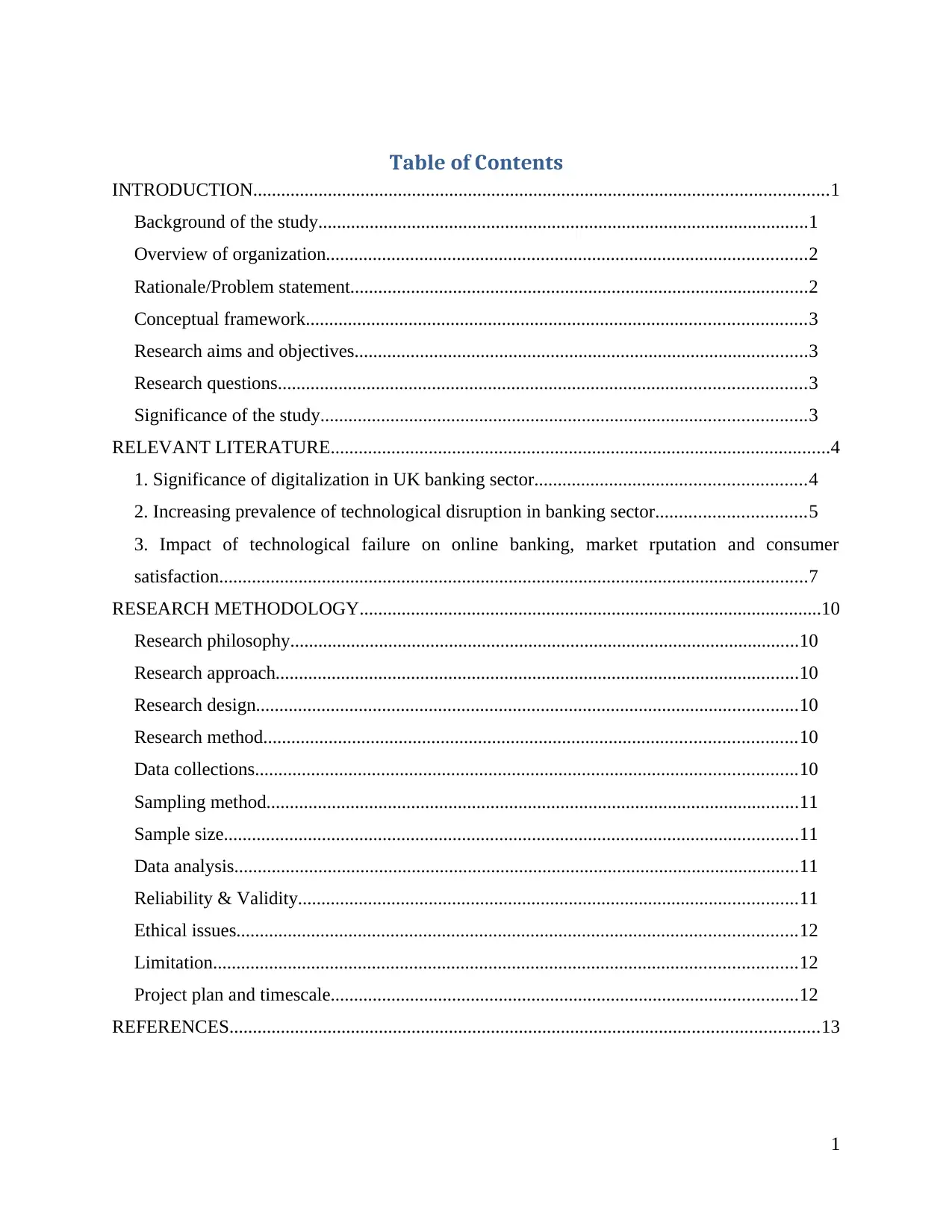
Table of Contents
INTRODUCTION...........................................................................................................................1
Background of the study.........................................................................................................1
Overview of organization.......................................................................................................2
Rationale/Problem statement..................................................................................................2
Conceptual framework...........................................................................................................3
Research aims and objectives.................................................................................................3
Research questions.................................................................................................................3
Significance of the study........................................................................................................3
RELEVANT LITERATURE...........................................................................................................4
1. Significance of digitalization in UK banking sector..........................................................4
2. Increasing prevalence of technological disruption in banking sector................................5
3. Impact of technological failure on online banking, market rputation and consumer
satisfaction..............................................................................................................................7
RESEARCH METHODOLOGY...................................................................................................10
Research philosophy.............................................................................................................10
Research approach................................................................................................................10
Research design....................................................................................................................10
Research method..................................................................................................................10
Data collections....................................................................................................................10
Sampling method..................................................................................................................11
Sample size...........................................................................................................................11
Data analysis.........................................................................................................................11
Reliability & Validity...........................................................................................................11
Ethical issues........................................................................................................................12
Limitation.............................................................................................................................12
Project plan and timescale....................................................................................................12
REFERENCES..............................................................................................................................13
1
INTRODUCTION...........................................................................................................................1
Background of the study.........................................................................................................1
Overview of organization.......................................................................................................2
Rationale/Problem statement..................................................................................................2
Conceptual framework...........................................................................................................3
Research aims and objectives.................................................................................................3
Research questions.................................................................................................................3
Significance of the study........................................................................................................3
RELEVANT LITERATURE...........................................................................................................4
1. Significance of digitalization in UK banking sector..........................................................4
2. Increasing prevalence of technological disruption in banking sector................................5
3. Impact of technological failure on online banking, market rputation and consumer
satisfaction..............................................................................................................................7
RESEARCH METHODOLOGY...................................................................................................10
Research philosophy.............................................................................................................10
Research approach................................................................................................................10
Research design....................................................................................................................10
Research method..................................................................................................................10
Data collections....................................................................................................................10
Sampling method..................................................................................................................11
Sample size...........................................................................................................................11
Data analysis.........................................................................................................................11
Reliability & Validity...........................................................................................................11
Ethical issues........................................................................................................................12
Limitation.............................................................................................................................12
Project plan and timescale....................................................................................................12
REFERENCES..............................................................................................................................13
1
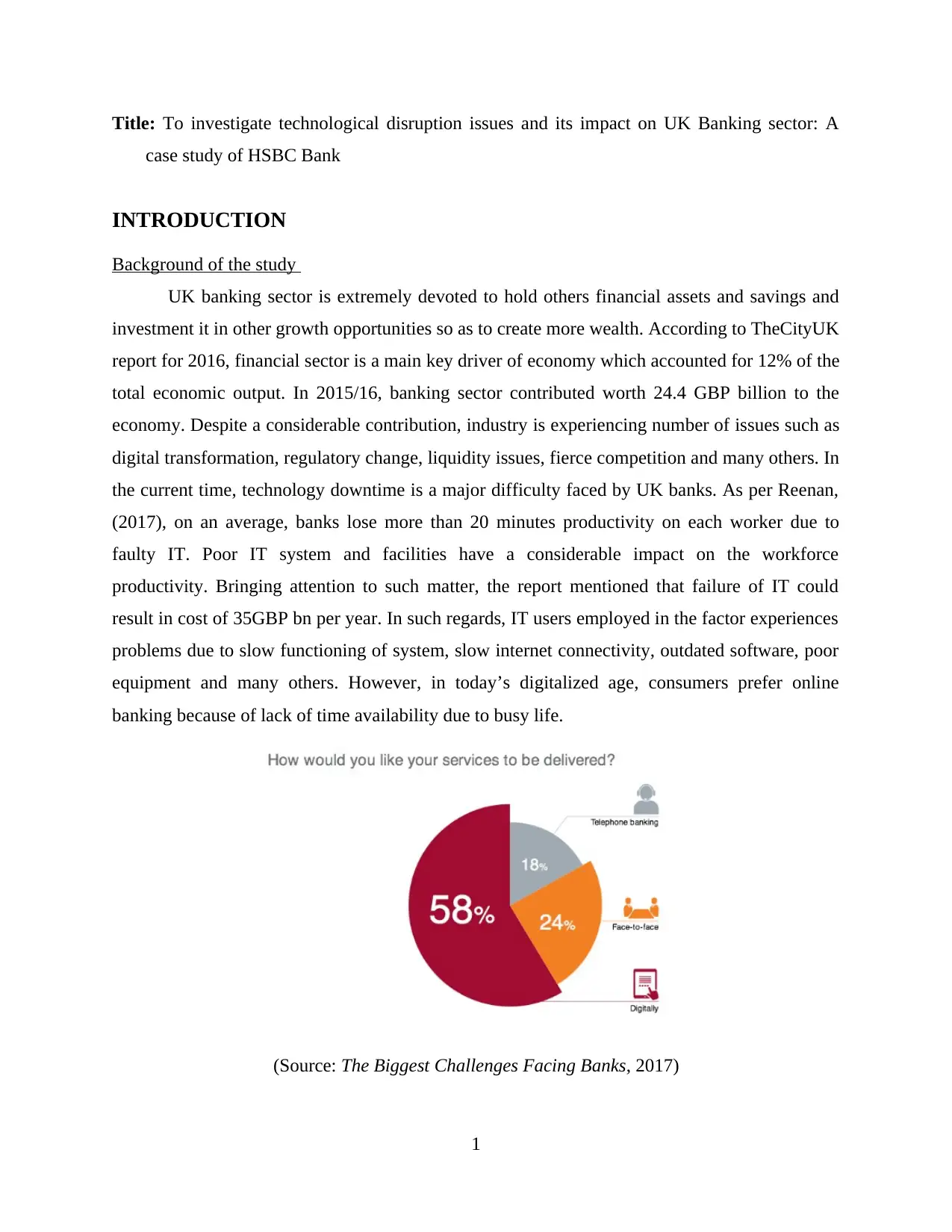
Title: To investigate technological disruption issues and its impact on UK Banking sector: A
case study of HSBC Bank
INTRODUCTION
Background of the study
UK banking sector is extremely devoted to hold others financial assets and savings and
investment it in other growth opportunities so as to create more wealth. According to TheCityUK
report for 2016, financial sector is a main key driver of economy which accounted for 12% of the
total economic output. In 2015/16, banking sector contributed worth 24.4 GBP billion to the
economy. Despite a considerable contribution, industry is experiencing number of issues such as
digital transformation, regulatory change, liquidity issues, fierce competition and many others. In
the current time, technology downtime is a major difficulty faced by UK banks. As per Reenan,
(2017), on an average, banks lose more than 20 minutes productivity on each worker due to
faulty IT. Poor IT system and facilities have a considerable impact on the workforce
productivity. Bringing attention to such matter, the report mentioned that failure of IT could
result in cost of 35GBP bn per year. In such regards, IT users employed in the factor experiences
problems due to slow functioning of system, slow internet connectivity, outdated software, poor
equipment and many others. However, in today’s digitalized age, consumers prefer online
banking because of lack of time availability due to busy life.
(Source: The Biggest Challenges Facing Banks, 2017)
1
case study of HSBC Bank
INTRODUCTION
Background of the study
UK banking sector is extremely devoted to hold others financial assets and savings and
investment it in other growth opportunities so as to create more wealth. According to TheCityUK
report for 2016, financial sector is a main key driver of economy which accounted for 12% of the
total economic output. In 2015/16, banking sector contributed worth 24.4 GBP billion to the
economy. Despite a considerable contribution, industry is experiencing number of issues such as
digital transformation, regulatory change, liquidity issues, fierce competition and many others. In
the current time, technology downtime is a major difficulty faced by UK banks. As per Reenan,
(2017), on an average, banks lose more than 20 minutes productivity on each worker due to
faulty IT. Poor IT system and facilities have a considerable impact on the workforce
productivity. Bringing attention to such matter, the report mentioned that failure of IT could
result in cost of 35GBP bn per year. In such regards, IT users employed in the factor experiences
problems due to slow functioning of system, slow internet connectivity, outdated software, poor
equipment and many others. However, in today’s digitalized age, consumers prefer online
banking because of lack of time availability due to busy life.
(Source: The Biggest Challenges Facing Banks, 2017)
1
⊘ This is a preview!⊘
Do you want full access?
Subscribe today to unlock all pages.

Trusted by 1+ million students worldwide
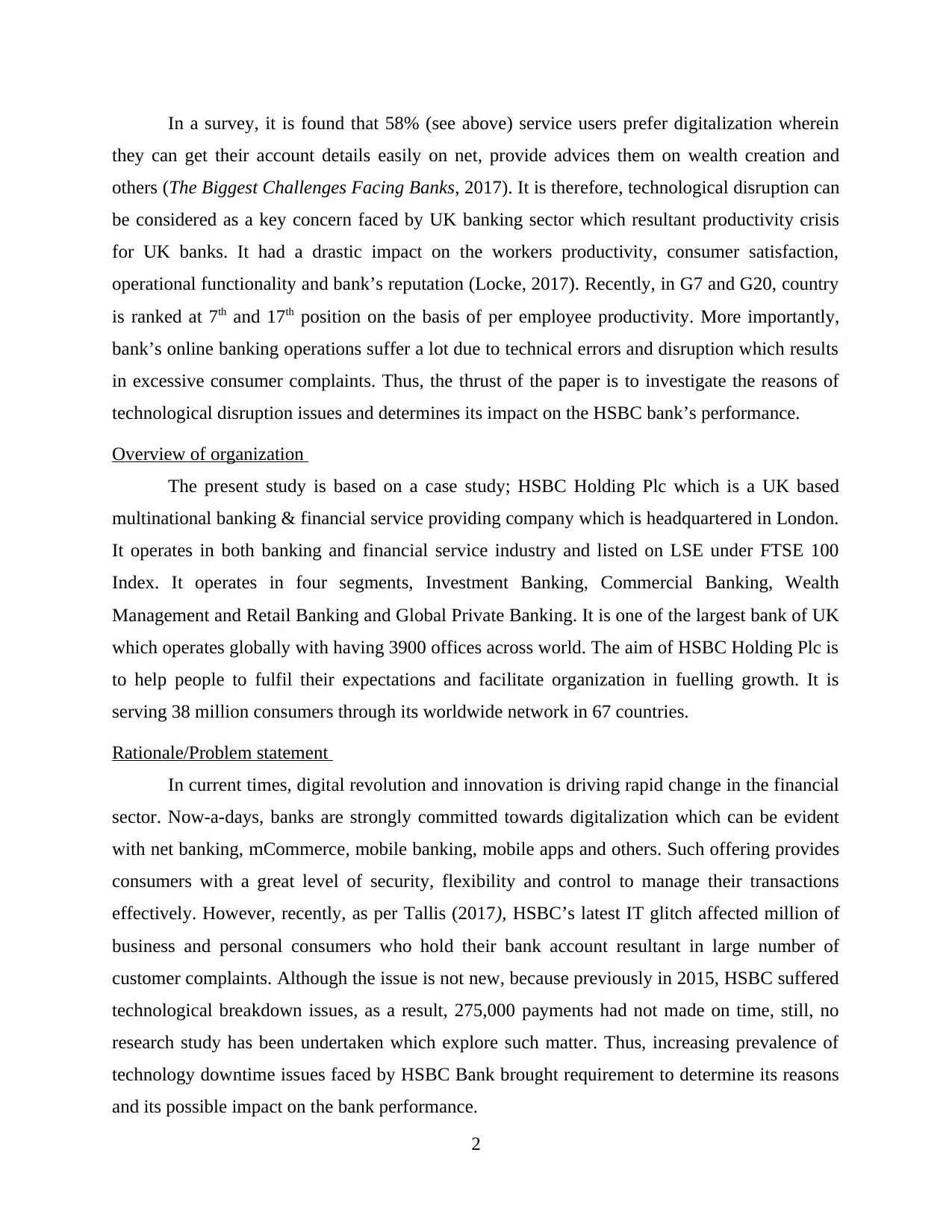
In a survey, it is found that 58% (see above) service users prefer digitalization wherein
they can get their account details easily on net, provide advices them on wealth creation and
others (The Biggest Challenges Facing Banks, 2017). It is therefore, technological disruption can
be considered as a key concern faced by UK banking sector which resultant productivity crisis
for UK banks. It had a drastic impact on the workers productivity, consumer satisfaction,
operational functionality and bank’s reputation (Locke, 2017). Recently, in G7 and G20, country
is ranked at 7th and 17th position on the basis of per employee productivity. More importantly,
bank’s online banking operations suffer a lot due to technical errors and disruption which results
in excessive consumer complaints. Thus, the thrust of the paper is to investigate the reasons of
technological disruption issues and determines its impact on the HSBC bank’s performance.
Overview of organization
The present study is based on a case study; HSBC Holding Plc which is a UK based
multinational banking & financial service providing company which is headquartered in London.
It operates in both banking and financial service industry and listed on LSE under FTSE 100
Index. It operates in four segments, Investment Banking, Commercial Banking, Wealth
Management and Retail Banking and Global Private Banking. It is one of the largest bank of UK
which operates globally with having 3900 offices across world. The aim of HSBC Holding Plc is
to help people to fulfil their expectations and facilitate organization in fuelling growth. It is
serving 38 million consumers through its worldwide network in 67 countries.
Rationale/Problem statement
In current times, digital revolution and innovation is driving rapid change in the financial
sector. Now-a-days, banks are strongly committed towards digitalization which can be evident
with net banking, mCommerce, mobile banking, mobile apps and others. Such offering provides
consumers with a great level of security, flexibility and control to manage their transactions
effectively. However, recently, as per Tallis (2017), HSBC’s latest IT glitch affected million of
business and personal consumers who hold their bank account resultant in large number of
customer complaints. Although the issue is not new, because previously in 2015, HSBC suffered
technological breakdown issues, as a result, 275,000 payments had not made on time, still, no
research study has been undertaken which explore such matter. Thus, increasing prevalence of
technology downtime issues faced by HSBC Bank brought requirement to determine its reasons
and its possible impact on the bank performance.
2
they can get their account details easily on net, provide advices them on wealth creation and
others (The Biggest Challenges Facing Banks, 2017). It is therefore, technological disruption can
be considered as a key concern faced by UK banking sector which resultant productivity crisis
for UK banks. It had a drastic impact on the workers productivity, consumer satisfaction,
operational functionality and bank’s reputation (Locke, 2017). Recently, in G7 and G20, country
is ranked at 7th and 17th position on the basis of per employee productivity. More importantly,
bank’s online banking operations suffer a lot due to technical errors and disruption which results
in excessive consumer complaints. Thus, the thrust of the paper is to investigate the reasons of
technological disruption issues and determines its impact on the HSBC bank’s performance.
Overview of organization
The present study is based on a case study; HSBC Holding Plc which is a UK based
multinational banking & financial service providing company which is headquartered in London.
It operates in both banking and financial service industry and listed on LSE under FTSE 100
Index. It operates in four segments, Investment Banking, Commercial Banking, Wealth
Management and Retail Banking and Global Private Banking. It is one of the largest bank of UK
which operates globally with having 3900 offices across world. The aim of HSBC Holding Plc is
to help people to fulfil their expectations and facilitate organization in fuelling growth. It is
serving 38 million consumers through its worldwide network in 67 countries.
Rationale/Problem statement
In current times, digital revolution and innovation is driving rapid change in the financial
sector. Now-a-days, banks are strongly committed towards digitalization which can be evident
with net banking, mCommerce, mobile banking, mobile apps and others. Such offering provides
consumers with a great level of security, flexibility and control to manage their transactions
effectively. However, recently, as per Tallis (2017), HSBC’s latest IT glitch affected million of
business and personal consumers who hold their bank account resultant in large number of
customer complaints. Although the issue is not new, because previously in 2015, HSBC suffered
technological breakdown issues, as a result, 275,000 payments had not made on time, still, no
research study has been undertaken which explore such matter. Thus, increasing prevalence of
technology downtime issues faced by HSBC Bank brought requirement to determine its reasons
and its possible impact on the bank performance.
2
Paraphrase This Document
Need a fresh take? Get an instant paraphrase of this document with our AI Paraphraser
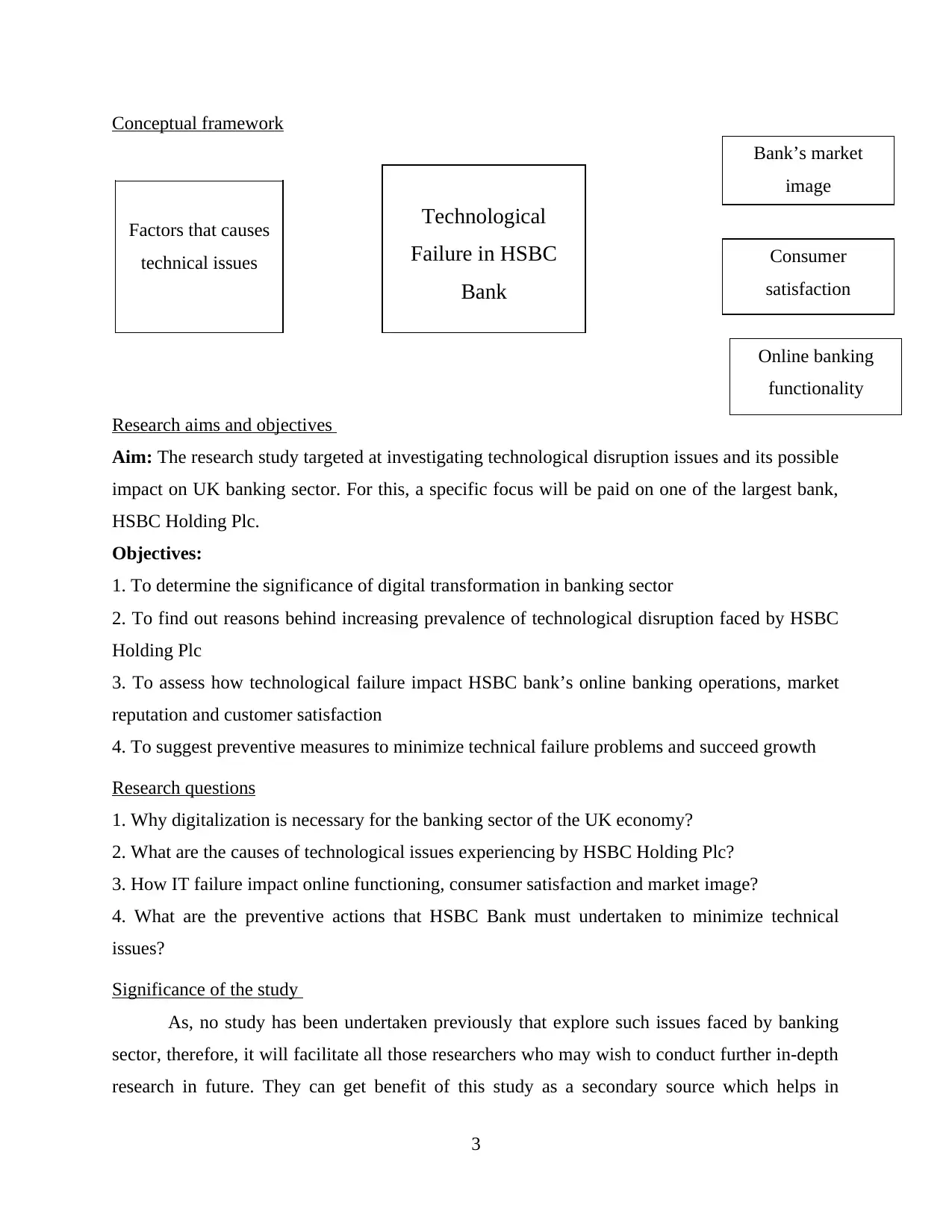
Conceptual framework
Research aims and objectives
Aim: The research study targeted at investigating technological disruption issues and its possible
impact on UK banking sector. For this, a specific focus will be paid on one of the largest bank,
HSBC Holding Plc.
Objectives:
1. To determine the significance of digital transformation in banking sector
2. To find out reasons behind increasing prevalence of technological disruption faced by HSBC
Holding Plc
3. To assess how technological failure impact HSBC bank’s online banking operations, market
reputation and customer satisfaction
4. To suggest preventive measures to minimize technical failure problems and succeed growth
Research questions
1. Why digitalization is necessary for the banking sector of the UK economy?
2. What are the causes of technological issues experiencing by HSBC Holding Plc?
3. How IT failure impact online functioning, consumer satisfaction and market image?
4. What are the preventive actions that HSBC Bank must undertaken to minimize technical
issues?
Significance of the study
As, no study has been undertaken previously that explore such issues faced by banking
sector, therefore, it will facilitate all those researchers who may wish to conduct further in-depth
research in future. They can get benefit of this study as a secondary source which helps in
3
Technological
Failure in HSBC
Bank
Factors that causes
technical issues
Bank’s market
image
Consumer
satisfaction
Online banking
functionality
Research aims and objectives
Aim: The research study targeted at investigating technological disruption issues and its possible
impact on UK banking sector. For this, a specific focus will be paid on one of the largest bank,
HSBC Holding Plc.
Objectives:
1. To determine the significance of digital transformation in banking sector
2. To find out reasons behind increasing prevalence of technological disruption faced by HSBC
Holding Plc
3. To assess how technological failure impact HSBC bank’s online banking operations, market
reputation and customer satisfaction
4. To suggest preventive measures to minimize technical failure problems and succeed growth
Research questions
1. Why digitalization is necessary for the banking sector of the UK economy?
2. What are the causes of technological issues experiencing by HSBC Holding Plc?
3. How IT failure impact online functioning, consumer satisfaction and market image?
4. What are the preventive actions that HSBC Bank must undertaken to minimize technical
issues?
Significance of the study
As, no study has been undertaken previously that explore such issues faced by banking
sector, therefore, it will facilitate all those researchers who may wish to conduct further in-depth
research in future. They can get benefit of this study as a secondary source which helps in
3
Technological
Failure in HSBC
Bank
Factors that causes
technical issues
Bank’s market
image
Consumer
satisfaction
Online banking
functionality
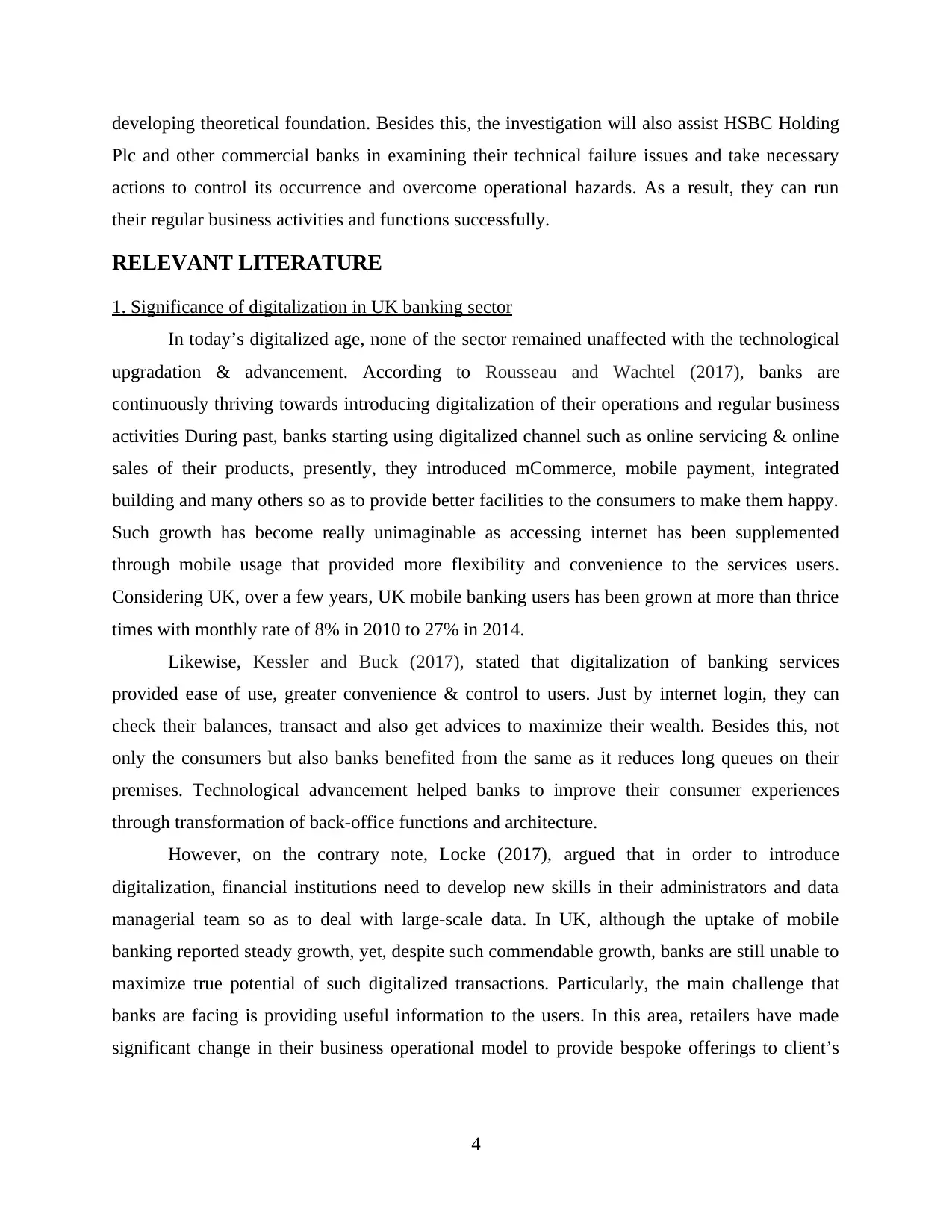
developing theoretical foundation. Besides this, the investigation will also assist HSBC Holding
Plc and other commercial banks in examining their technical failure issues and take necessary
actions to control its occurrence and overcome operational hazards. As a result, they can run
their regular business activities and functions successfully.
RELEVANT LITERATURE
1. Significance of digitalization in UK banking sector
In today’s digitalized age, none of the sector remained unaffected with the technological
upgradation & advancement. According to Rousseau and Wachtel (2017), banks are
continuously thriving towards introducing digitalization of their operations and regular business
activities During past, banks starting using digitalized channel such as online servicing & online
sales of their products, presently, they introduced mCommerce, mobile payment, integrated
building and many others so as to provide better facilities to the consumers to make them happy.
Such growth has become really unimaginable as accessing internet has been supplemented
through mobile usage that provided more flexibility and convenience to the services users.
Considering UK, over a few years, UK mobile banking users has been grown at more than thrice
times with monthly rate of 8% in 2010 to 27% in 2014.
Likewise, Kessler and Buck (2017), stated that digitalization of banking services
provided ease of use, greater convenience & control to users. Just by internet login, they can
check their balances, transact and also get advices to maximize their wealth. Besides this, not
only the consumers but also banks benefited from the same as it reduces long queues on their
premises. Technological advancement helped banks to improve their consumer experiences
through transformation of back-office functions and architecture.
However, on the contrary note, Locke (2017), argued that in order to introduce
digitalization, financial institutions need to develop new skills in their administrators and data
managerial team so as to deal with large-scale data. In UK, although the uptake of mobile
banking reported steady growth, yet, despite such commendable growth, banks are still unable to
maximize true potential of such digitalized transactions. Particularly, the main challenge that
banks are facing is providing useful information to the users. In this area, retailers have made
significant change in their business operational model to provide bespoke offerings to client’s
4
Plc and other commercial banks in examining their technical failure issues and take necessary
actions to control its occurrence and overcome operational hazards. As a result, they can run
their regular business activities and functions successfully.
RELEVANT LITERATURE
1. Significance of digitalization in UK banking sector
In today’s digitalized age, none of the sector remained unaffected with the technological
upgradation & advancement. According to Rousseau and Wachtel (2017), banks are
continuously thriving towards introducing digitalization of their operations and regular business
activities During past, banks starting using digitalized channel such as online servicing & online
sales of their products, presently, they introduced mCommerce, mobile payment, integrated
building and many others so as to provide better facilities to the consumers to make them happy.
Such growth has become really unimaginable as accessing internet has been supplemented
through mobile usage that provided more flexibility and convenience to the services users.
Considering UK, over a few years, UK mobile banking users has been grown at more than thrice
times with monthly rate of 8% in 2010 to 27% in 2014.
Likewise, Kessler and Buck (2017), stated that digitalization of banking services
provided ease of use, greater convenience & control to users. Just by internet login, they can
check their balances, transact and also get advices to maximize their wealth. Besides this, not
only the consumers but also banks benefited from the same as it reduces long queues on their
premises. Technological advancement helped banks to improve their consumer experiences
through transformation of back-office functions and architecture.
However, on the contrary note, Locke (2017), argued that in order to introduce
digitalization, financial institutions need to develop new skills in their administrators and data
managerial team so as to deal with large-scale data. In UK, although the uptake of mobile
banking reported steady growth, yet, despite such commendable growth, banks are still unable to
maximize true potential of such digitalized transactions. Particularly, the main challenge that
banks are facing is providing useful information to the users. In this area, retailers have made
significant change in their business operational model to provide bespoke offerings to client’s
4
⊘ This is a preview!⊘
Do you want full access?
Subscribe today to unlock all pages.

Trusted by 1+ million students worldwide
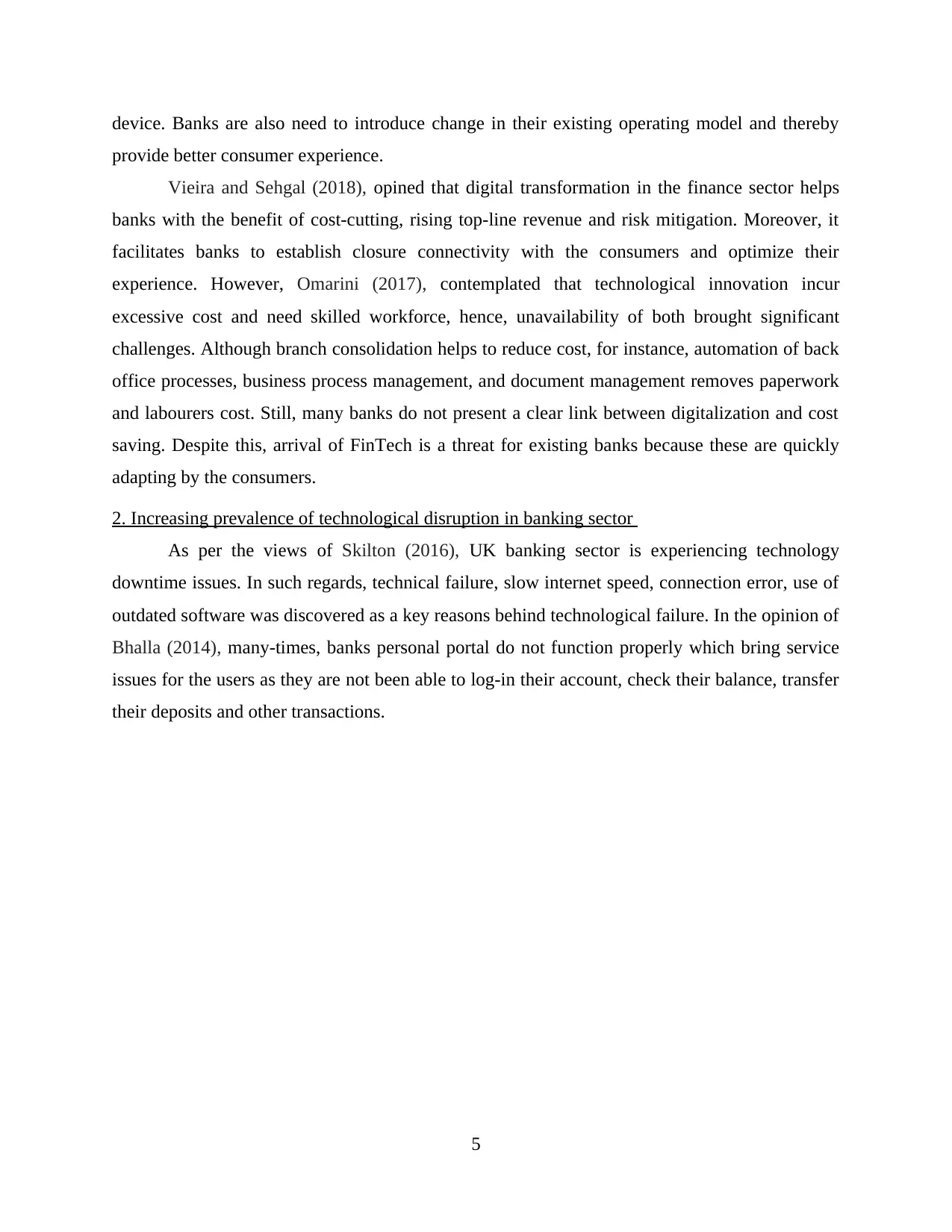
device. Banks are also need to introduce change in their existing operating model and thereby
provide better consumer experience.
Vieira and Sehgal (2018), opined that digital transformation in the finance sector helps
banks with the benefit of cost-cutting, rising top-line revenue and risk mitigation. Moreover, it
facilitates banks to establish closure connectivity with the consumers and optimize their
experience. However, Omarini (2017), contemplated that technological innovation incur
excessive cost and need skilled workforce, hence, unavailability of both brought significant
challenges. Although branch consolidation helps to reduce cost, for instance, automation of back
office processes, business process management, and document management removes paperwork
and labourers cost. Still, many banks do not present a clear link between digitalization and cost
saving. Despite this, arrival of FinTech is a threat for existing banks because these are quickly
adapting by the consumers.
2. Increasing prevalence of technological disruption in banking sector
As per the views of Skilton (2016), UK banking sector is experiencing technology
downtime issues. In such regards, technical failure, slow internet speed, connection error, use of
outdated software was discovered as a key reasons behind technological failure. In the opinion of
Bhalla (2014), many-times, banks personal portal do not function properly which bring service
issues for the users as they are not been able to log-in their account, check their balance, transfer
their deposits and other transactions.
5
provide better consumer experience.
Vieira and Sehgal (2018), opined that digital transformation in the finance sector helps
banks with the benefit of cost-cutting, rising top-line revenue and risk mitigation. Moreover, it
facilitates banks to establish closure connectivity with the consumers and optimize their
experience. However, Omarini (2017), contemplated that technological innovation incur
excessive cost and need skilled workforce, hence, unavailability of both brought significant
challenges. Although branch consolidation helps to reduce cost, for instance, automation of back
office processes, business process management, and document management removes paperwork
and labourers cost. Still, many banks do not present a clear link between digitalization and cost
saving. Despite this, arrival of FinTech is a threat for existing banks because these are quickly
adapting by the consumers.
2. Increasing prevalence of technological disruption in banking sector
As per the views of Skilton (2016), UK banking sector is experiencing technology
downtime issues. In such regards, technical failure, slow internet speed, connection error, use of
outdated software was discovered as a key reasons behind technological failure. In the opinion of
Bhalla (2014), many-times, banks personal portal do not function properly which bring service
issues for the users as they are not been able to log-in their account, check their balance, transfer
their deposits and other transactions.
5
Paraphrase This Document
Need a fresh take? Get an instant paraphrase of this document with our AI Paraphraser
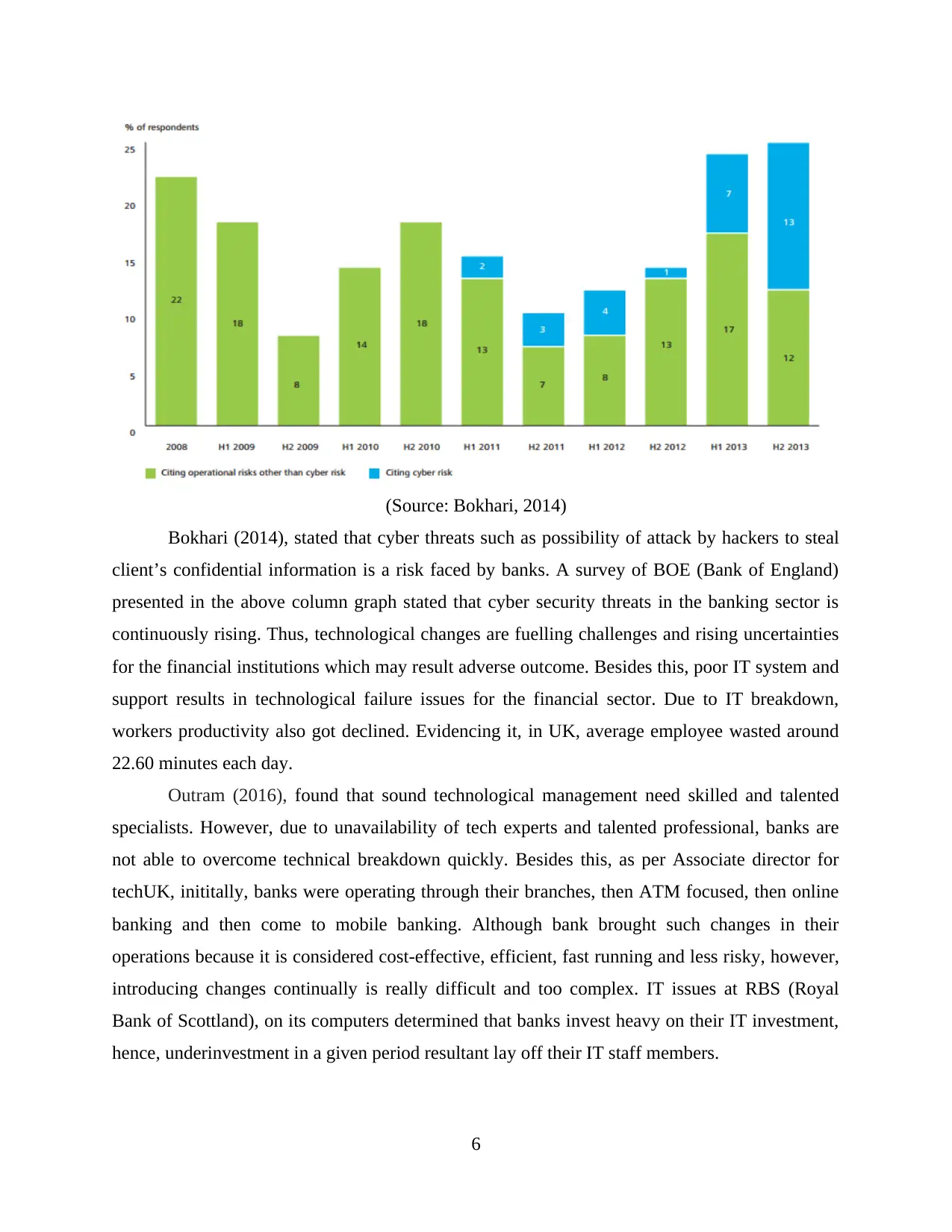
(Source: Bokhari, 2014)
Bokhari (2014), stated that cyber threats such as possibility of attack by hackers to steal
client’s confidential information is a risk faced by banks. A survey of BOE (Bank of England)
presented in the above column graph stated that cyber security threats in the banking sector is
continuously rising. Thus, technological changes are fuelling challenges and rising uncertainties
for the financial institutions which may result adverse outcome. Besides this, poor IT system and
support results in technological failure issues for the financial sector. Due to IT breakdown,
workers productivity also got declined. Evidencing it, in UK, average employee wasted around
22.60 minutes each day.
Outram (2016), found that sound technological management need skilled and talented
specialists. However, due to unavailability of tech experts and talented professional, banks are
not able to overcome technical breakdown quickly. Besides this, as per Associate director for
techUK, inititally, banks were operating through their branches, then ATM focused, then online
banking and then come to mobile banking. Although bank brought such changes in their
operations because it is considered cost-effective, efficient, fast running and less risky, however,
introducing changes continually is really difficult and too complex. IT issues at RBS (Royal
Bank of Scottland), on its computers determined that banks invest heavy on their IT investment,
hence, underinvestment in a given period resultant lay off their IT staff members.
6
Bokhari (2014), stated that cyber threats such as possibility of attack by hackers to steal
client’s confidential information is a risk faced by banks. A survey of BOE (Bank of England)
presented in the above column graph stated that cyber security threats in the banking sector is
continuously rising. Thus, technological changes are fuelling challenges and rising uncertainties
for the financial institutions which may result adverse outcome. Besides this, poor IT system and
support results in technological failure issues for the financial sector. Due to IT breakdown,
workers productivity also got declined. Evidencing it, in UK, average employee wasted around
22.60 minutes each day.
Outram (2016), found that sound technological management need skilled and talented
specialists. However, due to unavailability of tech experts and talented professional, banks are
not able to overcome technical breakdown quickly. Besides this, as per Associate director for
techUK, inititally, banks were operating through their branches, then ATM focused, then online
banking and then come to mobile banking. Although bank brought such changes in their
operations because it is considered cost-effective, efficient, fast running and less risky, however,
introducing changes continually is really difficult and too complex. IT issues at RBS (Royal
Bank of Scottland), on its computers determined that banks invest heavy on their IT investment,
hence, underinvestment in a given period resultant lay off their IT staff members.
6
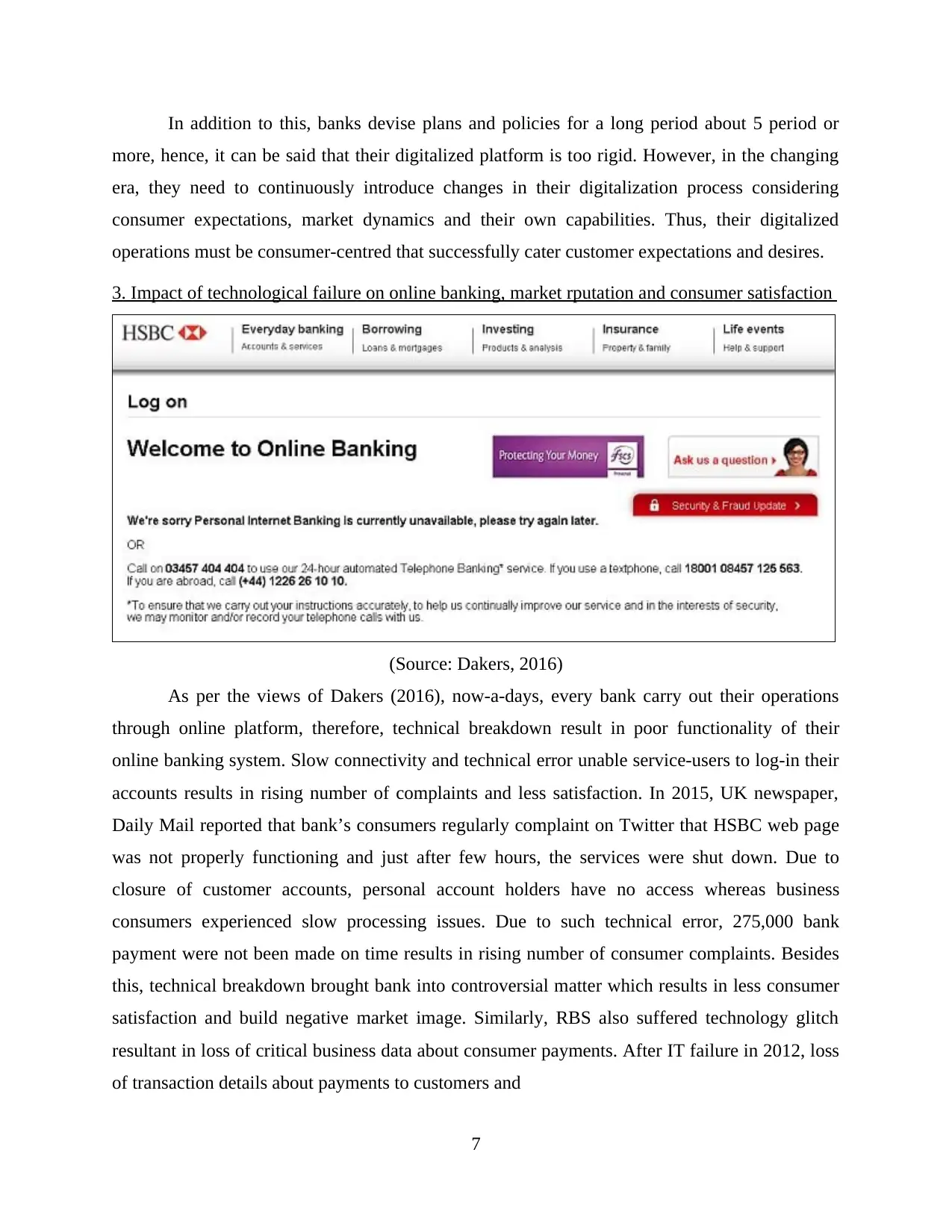
In addition to this, banks devise plans and policies for a long period about 5 period or
more, hence, it can be said that their digitalized platform is too rigid. However, in the changing
era, they need to continuously introduce changes in their digitalization process considering
consumer expectations, market dynamics and their own capabilities. Thus, their digitalized
operations must be consumer-centred that successfully cater customer expectations and desires.
3. Impact of technological failure on online banking, market rputation and consumer satisfaction
(Source: Dakers, 2016)
As per the views of Dakers (2016), now-a-days, every bank carry out their operations
through online platform, therefore, technical breakdown result in poor functionality of their
online banking system. Slow connectivity and technical error unable service-users to log-in their
accounts results in rising number of complaints and less satisfaction. In 2015, UK newspaper,
Daily Mail reported that bank’s consumers regularly complaint on Twitter that HSBC web page
was not properly functioning and just after few hours, the services were shut down. Due to
closure of customer accounts, personal account holders have no access whereas business
consumers experienced slow processing issues. Due to such technical error, 275,000 bank
payment were not been made on time results in rising number of consumer complaints. Besides
this, technical breakdown brought bank into controversial matter which results in less consumer
satisfaction and build negative market image. Similarly, RBS also suffered technology glitch
resultant in loss of critical business data about consumer payments. After IT failure in 2012, loss
of transaction details about payments to customers and
7
more, hence, it can be said that their digitalized platform is too rigid. However, in the changing
era, they need to continuously introduce changes in their digitalization process considering
consumer expectations, market dynamics and their own capabilities. Thus, their digitalized
operations must be consumer-centred that successfully cater customer expectations and desires.
3. Impact of technological failure on online banking, market rputation and consumer satisfaction
(Source: Dakers, 2016)
As per the views of Dakers (2016), now-a-days, every bank carry out their operations
through online platform, therefore, technical breakdown result in poor functionality of their
online banking system. Slow connectivity and technical error unable service-users to log-in their
accounts results in rising number of complaints and less satisfaction. In 2015, UK newspaper,
Daily Mail reported that bank’s consumers regularly complaint on Twitter that HSBC web page
was not properly functioning and just after few hours, the services were shut down. Due to
closure of customer accounts, personal account holders have no access whereas business
consumers experienced slow processing issues. Due to such technical error, 275,000 bank
payment were not been made on time results in rising number of consumer complaints. Besides
this, technical breakdown brought bank into controversial matter which results in less consumer
satisfaction and build negative market image. Similarly, RBS also suffered technology glitch
resultant in loss of critical business data about consumer payments. After IT failure in 2012, loss
of transaction details about payments to customers and
7
⊘ This is a preview!⊘
Do you want full access?
Subscribe today to unlock all pages.

Trusted by 1+ million students worldwide
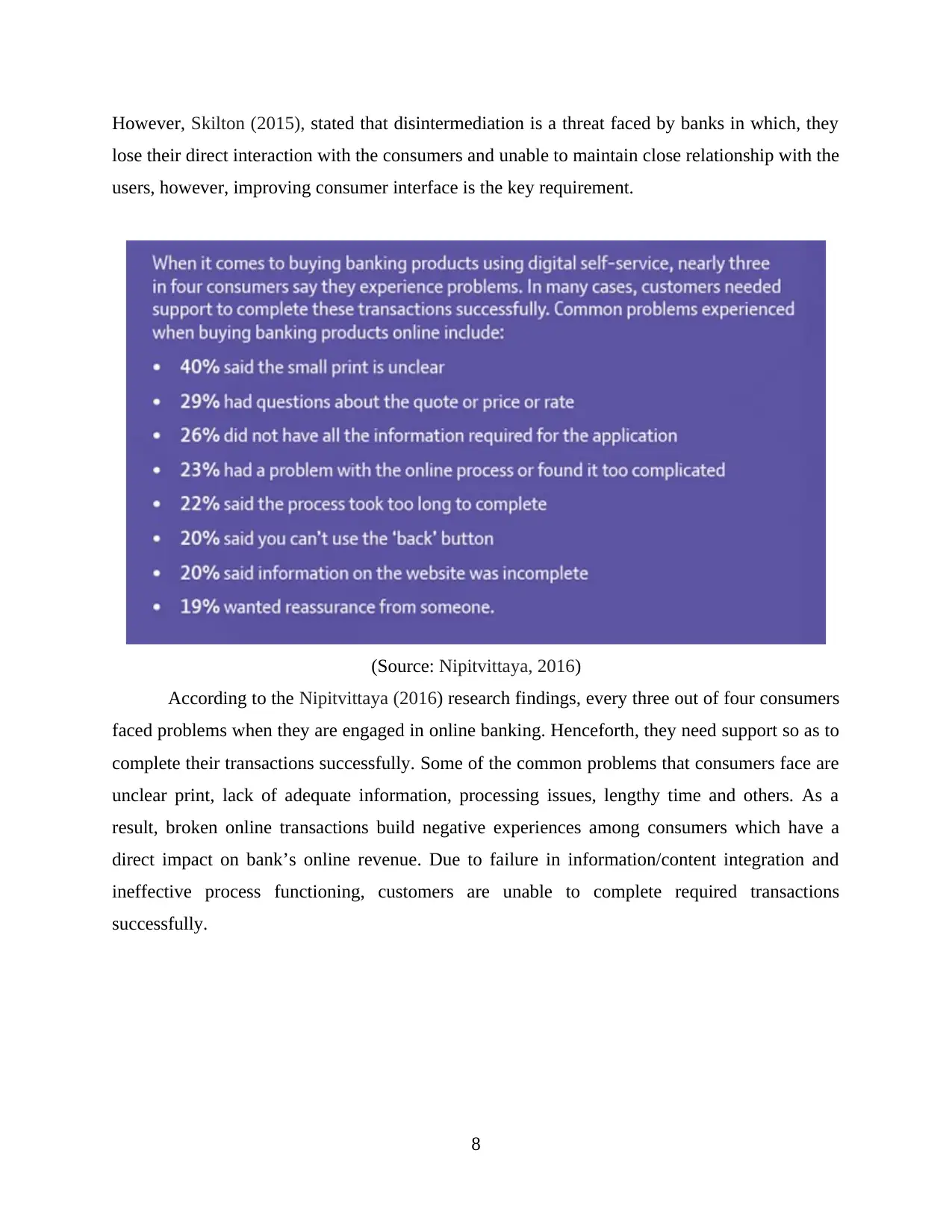
However, Skilton (2015), stated that disintermediation is a threat faced by banks in which, they
lose their direct interaction with the consumers and unable to maintain close relationship with the
users, however, improving consumer interface is the key requirement.
(Source: Nipitvittaya, 2016)
According to the Nipitvittaya (2016) research findings, every three out of four consumers
faced problems when they are engaged in online banking. Henceforth, they need support so as to
complete their transactions successfully. Some of the common problems that consumers face are
unclear print, lack of adequate information, processing issues, lengthy time and others. As a
result, broken online transactions build negative experiences among consumers which have a
direct impact on bank’s online revenue. Due to failure in information/content integration and
ineffective process functioning, customers are unable to complete required transactions
successfully.
8
lose their direct interaction with the consumers and unable to maintain close relationship with the
users, however, improving consumer interface is the key requirement.
(Source: Nipitvittaya, 2016)
According to the Nipitvittaya (2016) research findings, every three out of four consumers
faced problems when they are engaged in online banking. Henceforth, they need support so as to
complete their transactions successfully. Some of the common problems that consumers face are
unclear print, lack of adequate information, processing issues, lengthy time and others. As a
result, broken online transactions build negative experiences among consumers which have a
direct impact on bank’s online revenue. Due to failure in information/content integration and
ineffective process functioning, customers are unable to complete required transactions
successfully.
8
Paraphrase This Document
Need a fresh take? Get an instant paraphrase of this document with our AI Paraphraser
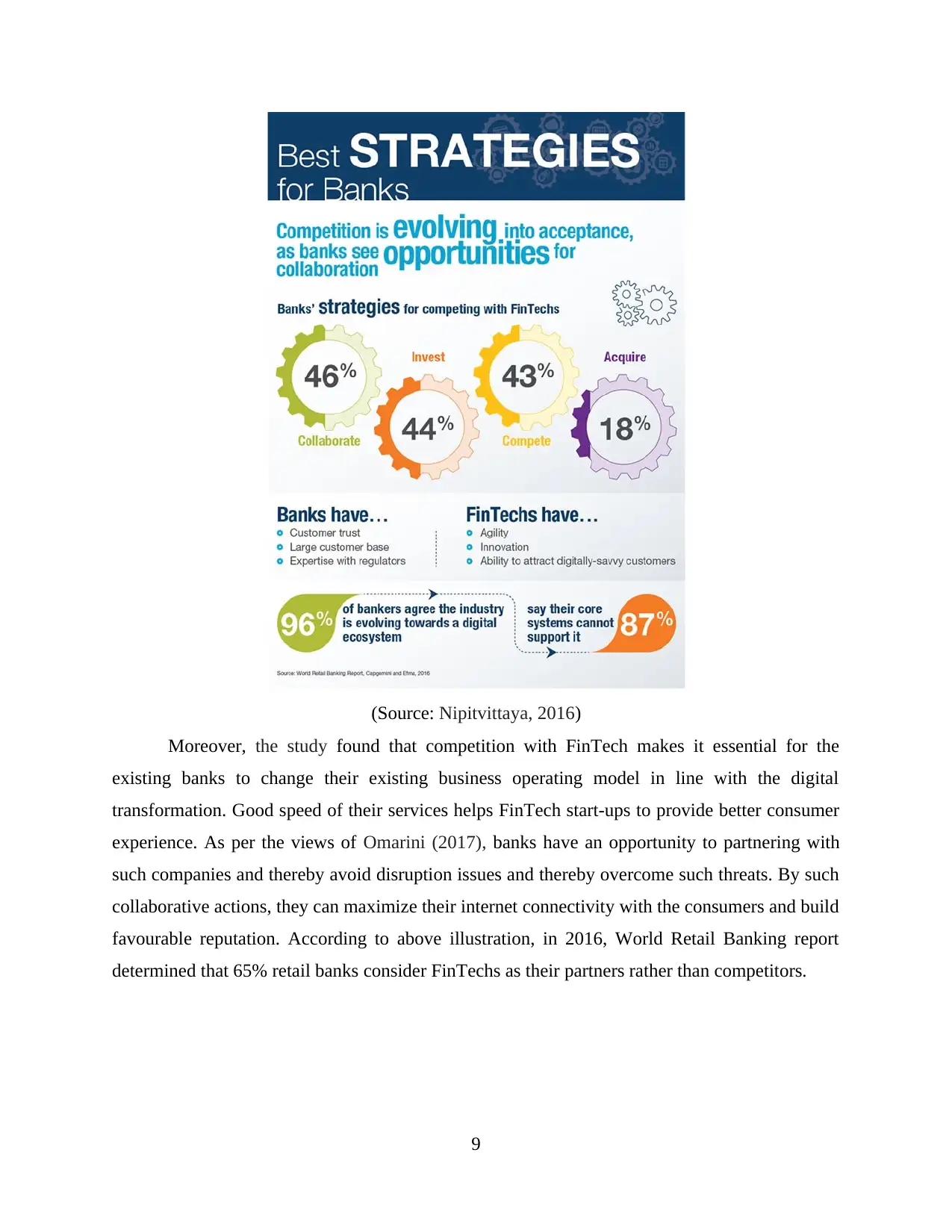
(Source: Nipitvittaya, 2016)
Moreover, the study found that competition with FinTech makes it essential for the
existing banks to change their existing business operating model in line with the digital
transformation. Good speed of their services helps FinTech start-ups to provide better consumer
experience. As per the views of Omarini (2017), banks have an opportunity to partnering with
such companies and thereby avoid disruption issues and thereby overcome such threats. By such
collaborative actions, they can maximize their internet connectivity with the consumers and build
favourable reputation. According to above illustration, in 2016, World Retail Banking report
determined that 65% retail banks consider FinTechs as their partners rather than competitors.
9
Moreover, the study found that competition with FinTech makes it essential for the
existing banks to change their existing business operating model in line with the digital
transformation. Good speed of their services helps FinTech start-ups to provide better consumer
experience. As per the views of Omarini (2017), banks have an opportunity to partnering with
such companies and thereby avoid disruption issues and thereby overcome such threats. By such
collaborative actions, they can maximize their internet connectivity with the consumers and build
favourable reputation. According to above illustration, in 2016, World Retail Banking report
determined that 65% retail banks consider FinTechs as their partners rather than competitors.
9
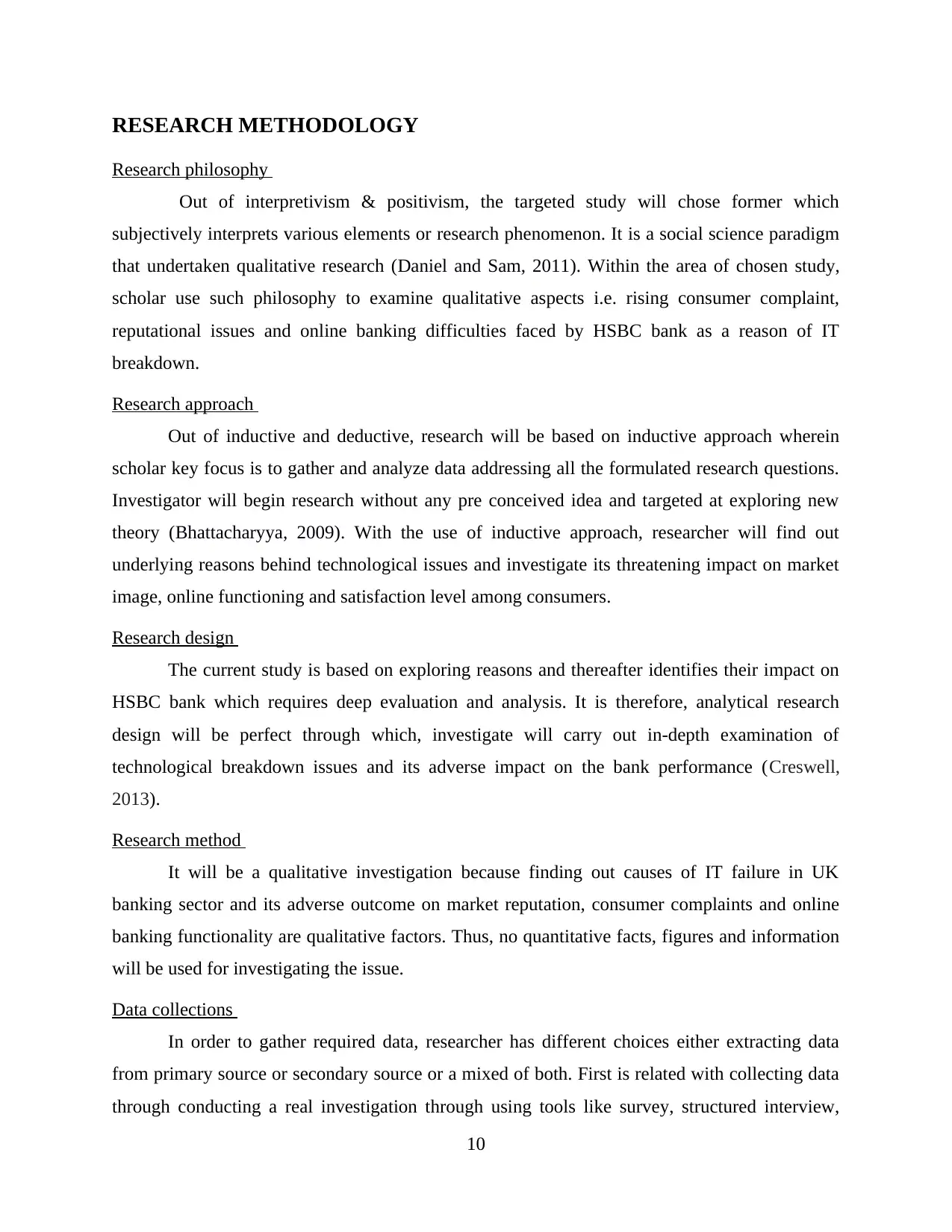
RESEARCH METHODOLOGY
Research philosophy
Out of interpretivism & positivism, the targeted study will chose former which
subjectively interprets various elements or research phenomenon. It is a social science paradigm
that undertaken qualitative research (Daniel and Sam, 2011). Within the area of chosen study,
scholar use such philosophy to examine qualitative aspects i.e. rising consumer complaint,
reputational issues and online banking difficulties faced by HSBC bank as a reason of IT
breakdown.
Research approach
Out of inductive and deductive, research will be based on inductive approach wherein
scholar key focus is to gather and analyze data addressing all the formulated research questions.
Investigator will begin research without any pre conceived idea and targeted at exploring new
theory (Bhattacharyya, 2009). With the use of inductive approach, researcher will find out
underlying reasons behind technological issues and investigate its threatening impact on market
image, online functioning and satisfaction level among consumers.
Research design
The current study is based on exploring reasons and thereafter identifies their impact on
HSBC bank which requires deep evaluation and analysis. It is therefore, analytical research
design will be perfect through which, investigate will carry out in-depth examination of
technological breakdown issues and its adverse impact on the bank performance (Creswell,
2013).
Research method
It will be a qualitative investigation because finding out causes of IT failure in UK
banking sector and its adverse outcome on market reputation, consumer complaints and online
banking functionality are qualitative factors. Thus, no quantitative facts, figures and information
will be used for investigating the issue.
Data collections
In order to gather required data, researcher has different choices either extracting data
from primary source or secondary source or a mixed of both. First is related with collecting data
through conducting a real investigation through using tools like survey, structured interview,
10
Research philosophy
Out of interpretivism & positivism, the targeted study will chose former which
subjectively interprets various elements or research phenomenon. It is a social science paradigm
that undertaken qualitative research (Daniel and Sam, 2011). Within the area of chosen study,
scholar use such philosophy to examine qualitative aspects i.e. rising consumer complaint,
reputational issues and online banking difficulties faced by HSBC bank as a reason of IT
breakdown.
Research approach
Out of inductive and deductive, research will be based on inductive approach wherein
scholar key focus is to gather and analyze data addressing all the formulated research questions.
Investigator will begin research without any pre conceived idea and targeted at exploring new
theory (Bhattacharyya, 2009). With the use of inductive approach, researcher will find out
underlying reasons behind technological issues and investigate its threatening impact on market
image, online functioning and satisfaction level among consumers.
Research design
The current study is based on exploring reasons and thereafter identifies their impact on
HSBC bank which requires deep evaluation and analysis. It is therefore, analytical research
design will be perfect through which, investigate will carry out in-depth examination of
technological breakdown issues and its adverse impact on the bank performance (Creswell,
2013).
Research method
It will be a qualitative investigation because finding out causes of IT failure in UK
banking sector and its adverse outcome on market reputation, consumer complaints and online
banking functionality are qualitative factors. Thus, no quantitative facts, figures and information
will be used for investigating the issue.
Data collections
In order to gather required data, researcher has different choices either extracting data
from primary source or secondary source or a mixed of both. First is related with collecting data
through conducting a real investigation through using tools like survey, structured interview,
10
⊘ This is a preview!⊘
Do you want full access?
Subscribe today to unlock all pages.

Trusted by 1+ million students worldwide
1 out of 16
Related Documents
Your All-in-One AI-Powered Toolkit for Academic Success.
+13062052269
info@desklib.com
Available 24*7 on WhatsApp / Email
![[object Object]](/_next/static/media/star-bottom.7253800d.svg)
Unlock your academic potential
Copyright © 2020–2025 A2Z Services. All Rights Reserved. Developed and managed by ZUCOL.




